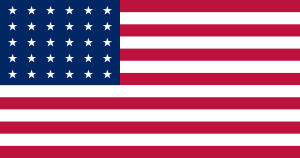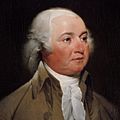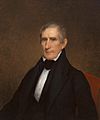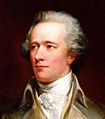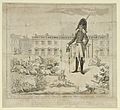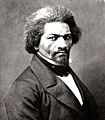History of the United States (1789–1849) facts for kids
This article is about the history of the United States from 1789 to 1849. This time is sometimes called the Antebellum period. It starts with George Washington becoming president and ends just before the American Civil War.
Before this, the first government under the Articles of Confederation had finished. A new government, based on the United States Constitution, then began. In the early 1800s, the country changed a lot. The United States grew bigger, cities became places where many factories were built, and the economy got stronger. Different parts of the country grew in different ways. This led to disagreements and eventually to the Civil War.
Contents
Early Years: The Federalist Era (1789-1801)
This period was when the Federalist Party mostly controlled the American government.
In 1789, George Washington was elected the first President of the United States. The Constitution did not say much about what a president should do. Washington helped define the job of president. He left office after two terms. During his time as president, there was a Whiskey Rebellion. This is when farmers tried to stop the government from collecting taxes on whiskey.
In 1795, Congress passed the Jay Treaty. This treaty allowed more trade with Britain. In return, the British gave up their forts on the Great Lakes. However, Great Britain still caused problems for the U.S. For example, they practiced "impressment," which meant forcing American sailors to join the British Royal Navy.
John Adams became the second President of the United States in 1796. He won against Thomas Jefferson. This was the first American election where two different political parties ran against each other. Under Adams, the United States Navy was created on April 30, 1798. It replaced an earlier navy that had been stopped by 1785. By the end of 1798, the U.S. Navy had 14 ships, and more were being built. Adams also supported and signed the Alien and Sedition Acts, which were very controversial.
In the election of 1800, Jefferson defeated Adams. One of the most important things Jefferson did as President was the Louisiana Purchase from France. This made the United States twice as big! By 1800, the U.S. had signed 24 treaties with nine European countries.
The Jeffersonian Period (1800-1815)
This time included the presidencies of two Democratic-Republican Party presidents: Thomas Jefferson and James Madison. They were often called Jeffersonian Republicans. During this period, the country nearly doubled in size because of the Louisiana Purchase from France. This expansion was one reason for the War of 1812. In that war, Great Britain tried to take back its former American colonies.
The "Era of Good Feelings" (1815-1825)
In 1816, James Monroe, a Democratic-Republican, easily won the presidential election. The Federalist Party candidate, Rufus King, lost badly. This was the last time the Federalist Party ran a candidate for president. By 1818, the Democratic-Republicans had most of the seats in Congress.
Monroe was president for two terms, from 1817 to 1825. Because one political party was so strong, this time is often called the "Era of Good Feelings." However, the Democratic-Republican party itself was divided. Many ideas from the Federalist Party, like those of Alexander Hamilton, were adopted during this time. Monroe continued many of the economic plans of Madison. Three important ideas were:
- Having a national bank
- Using protective tariffs (taxes on imported goods to help local businesses)
- The federal government helping to pay for infrastructure (like roads and canals).
A New Two-Party System
The "Era of Good Feelings," where politicians cooperated, lasted only about ten years. It was replaced by a new two-party system, which is still around today. Political parties started to bring together many different groups with different interests. This new system moved away from choosing people for jobs based on personal loyalty. The Founding Fathers of the United States had not planned for political parties. But by the 1830s, parties had become the main way American politics worked.
The presidential election of 1824 had no Federalist party candidate. There were five candidates. Andrew Jackson won the most electoral votes, but not a clear majority. John Quincy Adams came in second. Because no one had a clear majority, the House of Representatives had to decide, following the Twelfth Amendment to the United States Constitution.
Henry Clay, who was the Speaker of the House and also a candidate in 1824, helped elect Adams president. Even though his home state wanted him to vote for Jackson, Clay worked with others to choose Adams. Adams won on the first vote. At first, Jackson accepted the decision. But after Adams became president, he made Clay his Secretary of State. This led to cries of a "corrupt bargain" between Clay and Adams. Jackson's political campaign for the 1828 election began right away. He wanted to make sure Adams would only be president for one term.
The Era of Jacksonian Democracy (1828-1840s)
Andrew Jackson was elected president in 1828. He won nearly 70% of the electoral votes. More than 60% of eligible voters participated in this election. This was largely because Jackson was very popular as "Old Hickory," the hero of the Battle of New Orleans. He had served in the Revolutionary War, the War of 1812, and the Seminole Wars. Jackson also gained support because of the idea of a corrupt bargain between Adams and Clay.
During his presidency, Jackson started the party that called itself the "American Democracy." Changes in voting rules and political campaigns made people feel the country was becoming more democratic. For these reasons, this time was called Jacksonian democracy. This period lasted from 1828 into the 1840s, but its ideas lasted much longer. It was a time of democratic changes in voting and how the federal government was set up. Some historians see this era as having a contradiction in terms. This is because it also supported slavery, pushed Native Americans westward, and upheld white supremacy. Jackson's policies during his two terms were mostly about laissez-faire, meaning the government should interfere less with the economy.
The Democratic Party
Jackson's Democratic Party wanted a smaller, simpler government. They believed the government should not get involved in the economy or in controlling business. They were against religious groups interfering with government, especially on topics like the temperance (reducing alcohol use), abolitionism (ending slavery), and officially keeping the Sabbath. Jackson and his Democrats wanted to keep government spending very low.
The Democrats, led by Jackson and his successor Martin Van Buren, became much better organized. They created a structure of local, state, and national groups. These groups managed members and held their caucuses and political conventions. They said they were a grassroots party (meaning they were controlled by ordinary people), but they were actually controlled from Washington. They presented themselves as defending the common person against the "aristocrats" of the Whig Party. They started a spoils system, which meant giving government jobs to people who were loyal to the party.
After the War of 1812, changes to the Constitution allowed more men to vote by removing the rule that you had to own property. By Jackson's presidency, almost all white men could vote. In 1812, only half of the states chose their presidential electors by popular vote. By 1832, all states except South Carolina chose their presidential electors this way. The Democrats quickly used these changes to their advantage.
The Nullification Crisis (1832-1833)
Jacksonian Democrats fought against the Second Bank of the United States. They wanted to reduce the political power of bankers over the national economy. They helped farmers and planters by taking Native American lands and making cheap land available for settlers. But this did not get them the support of all planters in the South.
Some, mostly in South Carolina, thought that Jackson's idea of egalitarianism (equality for all) might threaten slavery. This led to the Nullification Crisis of 1832-1833. Farmers and planters had hoped that Jackson would lower the unpopular tariffs. These tariffs helped Northern manufacturers but hurt the South's economy. South Carolina passed the Ordinance of Nullification. This law said that the federal tariffs of 1828 and 1838 were illegal within South Carolina. They also started to raise funds for a military to defend themselves.
In November 1832, Jackson sent seven navy ships and one warship to Charleston. He called South Carolina's act "insurrection and treason." Other Southern states may have agreed with South Carolina's feelings, but they called South Carolina's actions unconstitutional. South Carolina eventually gave in and removed their objections to the tariff. In response, in 1833, Henry Clay helped pass a bill in Congress that slowly reduced the tariff for any that were over 20%. So, in the end, South Carolina had shown it could force its will on Congress by resisting a federal law.
Social Reforms
Many reform movements began after 1815. The better economy after the War of 1812 meant a new group of people had time and money to join social movements. New printing technologies meant more books and newspapers were published, including those about ending slavery. Better transportation made it easier for speakers to travel.
A temperance movement (against alcohol) started around 1819. A religious movement, sometimes called the Second Great Awakening, spread across the country. Most of these reform movements shared common ideas. One important belief was that people could choose between right and wrong. For example, slavery was seen as wrong. The word "slave" was used to describe anything considered wrong in society. Drunkards were "slaves" to alcohol, workers were "slaves" to factory owners, and women were "slaves" to men.
It was also common for people who believed in anti-slavery movements to also believe in women's rights, religious reforms, and temperance reforms. People often joined local groups because there were no strong national political or church leaders for these causes. Reform movements worked outside the political and religious systems, at least until the 1840s. The movements themselves, like the abolitionist movement, were not completely united and had disagreements about what to do or how to do it.
Slavery in the Antebellum Period
By 1830, slavery was mostly found in the South. Slaves worked on small farms and large plantations. They also worked in towns as domestic workers and labor for different industries. Slaves were seen as property because they were black. They were kept as slaves through the constant threat of violence. They were not allowed to forget they were slaves, even if they lived with their masters. Many slave owners genuinely cared about their slaves but never saw them as equals.
However, most Southerners did not own slaves. Most Southerners worked their own farms. Yet, many of them still defended slavery. Many disliked the wealth and power of the large plantation owners. But at the same time, they hoped that someday they could become rich plantation owners themselves. Also, while poor Southerners were looked down on by rich plantation owners, they could themselves look down on black people as an inferior group.
Cotton became the biggest cash crop. But plantations also grew corn, rice, sugarcane, and tobacco. Plantations might have had an average of 50 or fewer slaves, but the largest plantations had hundreds. Besides field work, slaves were also skilled in trades like blacksmithing, carpentry, and mechanics. Domestic slaves cooked for the family, raised children, and did all the work in the household. They were always watched and had to work whenever they were not sleeping. Domestic slaves had virtually no privacy. Young white children often formed close bonds with their black nannies. But as they grew up, they were educated on how slaves were to be treated.
The Agrarian South
During this time, cotton plantations in the South became very profitable. New inventions like the cotton gin, power looms, and the Sewing machine created a huge demand for cotton. Cotton was exported from the South to New England and to England. Plantation owners needed more land and more slaves to grow more cotton. They especially wanted to expand into new territories. They needed more slaves, and after the ban on importing African slaves into the U.S., prices went up. Small farmers found it profitable to sell their slaves to the large plantation owners. Wealth in the South often depended on how many slaves a planter owned. Slaves also gave them political power and prestige.
The Industrial North
The textile industry started the Industrial Revolution in the North. Other advances in manufacturing were in making paint, furniture, paper, and glass. Between 1814 and 1865, the population grew four times. Manufacturing output grew twelve times, and the price of manufactured goods grew eight times what it was before. Most of this growth was in New England. Rivers provided power for mills. In Pennsylvania, coal and iron ore were mined.
Farming remained an important industry in the North. Schools provided education, which meant a supply of educated workers and inventors. Large ports and ships provided transportation to foreign markets. Also, railroads and water transportation, like the Erie Canal, moved goods and services further west. A steady supply of immigrants provided much of the labor force that worked in the Northern industries. During this period, several social movements, including anti-slavery, began to have a noticeable effect on society. In 1831, more radical forms of abolitionist movements (those wanting to end slavery) emerged.
U.S. Presidents (1789-1849)
Images for kids
-
George Washington, first U.S. president. (Lansdowne portrait by Gilbert Stuart, 1796)
-
John Adams, Second U.S. President
-
Alexander Hamilton, First U.S. Secretary of the Treasury
-
Tecumseh and Governor William Henry Harrison; Tecumseh's death in the Battle of the Thames in 1813 ended British hopes to create a neutral Indian state in the Midwest
-
Caucus curs in full yell, by James Akin, 1824 (a critique of how the press treated Andrew Jackson and how candidates were chosen by caucus)
-
Selocta (or Shelocta) was a Muscogee chief who asked Andrew Jackson to reduce the demands for Creek lands at the signing of the Treaty of Fort Jackson.
-
Picking cotton in Georgia
-
Jackson slays the many-headed monster that is the Bank of the United States
See also
 In Spanish: Historia de los Estados Unidos (1789-1849) para niños
In Spanish: Historia de los Estados Unidos (1789-1849) para niños


